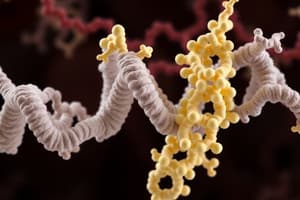Podcast
Questions and Answers
What is the primary role of chaperones in cellular biology?
What is the primary role of chaperones in cellular biology?
- To facilitate the degradation of misfolded proteins
- To assist in the proper folding of newly made proteins (correct)
- To transport proteins to different cellular compartments
- To act as enzymes in metabolic pathways
Which type of chaperone is responsible for creating a folding chamber for proteins?
Which type of chaperone is responsible for creating a folding chamber for proteins?
- Molecular chaperones
- Heat shock proteins
- Lipid chaperones
- Chaperonins (correct)
In the context of protein folding, what do heat shock proteins (HSPs) primarily respond to?
In the context of protein folding, what do heat shock proteins (HSPs) primarily respond to?
- Environmental stress (correct)
- Nutrient availability
- DNA replication
- Cellular respiration rates
What is a key characteristic of molecular chaperones?
What is a key characteristic of molecular chaperones?
What triggers the opening and closing of the lid in chaperonins?
What triggers the opening and closing of the lid in chaperonins?
What happens when proteins misfold and aggregate?
What happens when proteins misfold and aggregate?
Which statement correctly describes the concept of Anfinsen's Dogma?
Which statement correctly describes the concept of Anfinsen's Dogma?
Which chaperone is crucial in the endoplasmic reticulum stress response?
Which chaperone is crucial in the endoplasmic reticulum stress response?
Which statement about chaperones is true?
Which statement about chaperones is true?
How do chaperones assist proteins during the folding process?
How do chaperones assist proteins during the folding process?
Flashcards are hidden until you start studying
Study Notes
Chaperones Overview
- Proteins that help newly synthesized proteins fold correctly and prevent them from clumping together
- Found in all living things, from bacteria to humans, using similar mechanisms for protein folding
- Many chaperones are evolutionarily conserved, meaning they have remained similar throughout the history of life
Types of Chaperones
- Molecular Chaperones: Bind to short sections of unfolded proteins, preventing aggregation and stabilizing them
- Examples include Hsp70 family (found in the cytoplasm and mitochondria), BiP (Grp78 in the endoplasmic reticulum), and DnaK (in bacteria)
- Prevent improper interactions or premature folding by binding to hydrophobic regions of unfolded proteins
- Chaperonins: Create a folding chamber that isolates the unfolded protein and allows it to fold properly in a controlled environment
- Allow for proper folding by sequestering the protein inside a folding chamber
Heat Shock Proteins (HSPs)
- Upregulated (increased in number) in response to stress such as heat, cold, or exposure to chemicals
- Protect cells by assisting in protein folding under stressful conditions
- Key Example: Hsp70 is upregulated during heat shock or exposure to toxins
- Link to Aging: HSP expression increases with age and in diseases like Huntington's and Alzheimer's
Protein Folding Challenges
- Theory: Proteins fold into their lowest energy, stable state (Anfinsen's Dogma)
- Reality: Folding in cells is complex due to stress, crowded environments, and competing interactions, making chaperones essential
- Competition: Proteins can either fold correctly or misfold and aggregate; chaperones help guide folding towards the correct structure
Molecular Chaperones
- Assist protein folding by binding to hydrophobic regions, disrupting incorrect interactions and stabilizing correct ones
- BiP (Grp78): Important in the ER stress response and plays a role in diseases like prostate cancer (has anti-apoptotic effects when bound to the NH2-terminal domain)
Chaperonin-Mediated Folding
- Structure: Chaperonins (like bacterial Group I or mammalian Group II) form multi-subunit chambers where proteins fold
- ATP hydrolysis triggers the lid's opening and closing, allowing controlled folding within the chamber
Studying That Suits You
Use AI to generate personalized quizzes and flashcards to suit your learning preferences.




